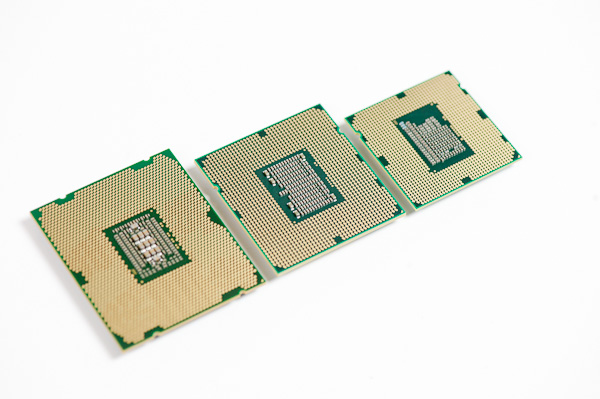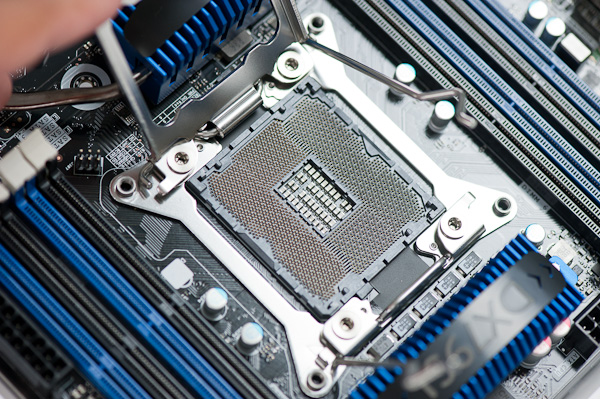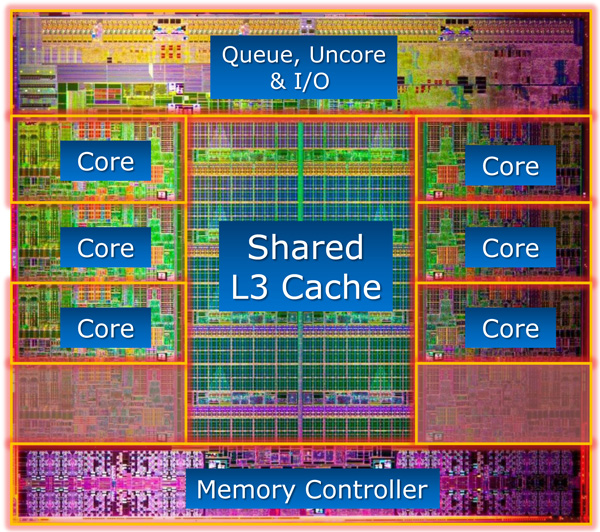Intel Core i7 3960X (Sandy Bridge E) Review: Keeping the High End Alive
by Anand Lal Shimpi on November 14, 2011 3:01 AM EST- Posted in
- CPUs
- Intel
- Core i7
- Sandy Bridge
- Sandy Bridge E
If you look carefully enough, you may notice that things are changing. It first became apparent shortly after the release of Nehalem. Intel bifurcated the performance desktop space by embracing a two-socket strategy, something we'd never seen from Intel and only once from AMD in the early Athlon 64 days (Socket-940 and Socket-754).
LGA-1366 came first, but by the time LGA-1156 arrived a year later it no longer made sense to recommend Intel's high-end Nehalem platform. Lynnfield was nearly as fast and the entire platform was more affordable.
When Sandy Bridge launched earlier this year, all we got was the mainstream desktop version. No one complained because it was fast enough, but we all knew an ultra high-end desktop part was in the works. A true successor to Nehalem's LGA-1366 platform for those who waited all this time.

Left to right: Sandy Bridge E, Gulftown, Sandy Bridge
After some delays, Sandy Bridge E is finally here. The platform is actually pretty simple to talk about. There's a new socket: LGA-2011, a new chipset Intel's X79 and of course the Sandy Bridge E CPU itself. We'll start at the CPU.
For the desktop, Sandy Bridge E is only available in 6-core configurations at launch. Early next year we'll see a quad-core version. I mention the desktop qualification because Sandy Bridge E is really a die harvested Sandy Bridge EP, Intel's next generation Xeon part:
If you look carefully at the die shot above, you'll notice that there are actually eight Sandy Bridge cores. The Xeon version will have all eight enabled, but the last two are fused off for SNB-E. The 32nm die is absolutely gigantic by desktop standards, measuring 20.8 mm x 20.9 mm (~435mm^2) Sandy Bridge E is bigger than most GPUs. It also has a ridiculous number of transistors: 2.27 billion.
Around a quarter of the die is dedicated just to the chip's massive L3 cache. Each cache slice has increased in size compared to Sandy Bridge. Instead of 2MB, Sandy Bridge E boasts 2.5MB cache slices. In its Xeon configuration that works out to 20MB of L3 cache, but for desktops it's only 15MB. That's just 1MB shy of how much system memory my old upgraded 386-SX/20 had.
| CPU Specification Comparison | ||||||||
| CPU | Manufacturing Process | Cores | Transistor Count | Die Size | ||||
| AMD Bulldozer 8C | 32nm | 8 | 1.2B* | 315mm2 | ||||
| AMD Thuban 6C | 45nm | 6 | 904M | 346mm2 | ||||
| AMD Deneb 4C | 45nm | 4 | 758M | 258mm2 | ||||
| Intel Gulftown 6C | 32nm | 6 | 1.17B | 240mm2 | ||||
| Intel Sandy Bridge E (6C) | 32nm | 6 | 2.27B | 435mm2 | ||||
| Intel Nehalem/Bloomfield 4C | 45nm | 4 | 731M | 263mm2 | ||||
| Intel Sandy Bridge 4C | 32nm | 4 | 995M | 216mm2 | ||||
| Intel Lynnfield 4C | 45nm | 4 | 774M | 296mm2 | ||||
| Intel Clarkdale 2C | 32nm | 2 | 384M | 81mm2 | ||||
| Intel Sandy Bridge 2C (GT1) | 32nm | 2 | 504M | 131mm2 | ||||
| Intel Sandy Bridge 2C (GT2) | 32nm | 2 | 624M | 149mm2 | ||||
Update: AMD originally told us Bulldozer was a 2B transistor chip. It has since told us that the 8C Bulldozer is actually 1.2B transistors. The die size is still accurate at 315mm2.
At the core level, Sandy Bridge E is no different than Sandy Bridge. It doesn't clock any higher, L1/L2 caches remain unchanged and per-core performance is identical to what Intel launched earlier this year.
The Lineup
| Processor | Core Clock | Cores / Threads | L3 Cache | Max Turbo | Max Overclock Multiplier | TDP | Price |
| Intel Core i7 3960X | 3.3GHz | 6 / 12 | 15MB | 3.9GHz | 57x | 130W | $990 |
| Intel Core i7 3930K | 3.2GHz | 6 / 12 | 12MB | 3.8GHz | 57x | 130W | $555 |
| Intel Core i7 3820 | 3.6GHz | 4 / 8 | 10MB | 3.9GHz | 43x | 130W | TBD |
| Intel Core i7 2700K | 3.5GHz | 4 / 8 | 8MB | 3.9GHz | 57x | 95W | $332 |
| Intel Core i7 2600K | 3.4GHz | 4 / 8 | 8MB | 3.8GHz | 57x | 95W | $317 |
| Intel Core i7 2600 | 3.4GHz | 4 / 8 | 8MB | 3.8GHz | 42x | 95W | $294 |
| Intel Core i5 2500K | 3.3GHz | 4 / 4 | 6MB | 3.7GHz | 57x | 95W | $216 |
| Intel Core i5 2500 | 3.3GHz | 4 / 4 | 6MB | 3.7GHz | 41x | 95W | $205 |
Those of you buying today only have two options: the Core i7-3960X and the Core i7-3930K. Both have six fully unlocked cores, but the 3960X gives you a 15MB L3 cache vs. 12MB with the 3930K. You pay handsomely for that extra 3MB of L3. The 3960X goes for $990 in 1K unit quantities, while the 3930K sells for $555.
The 3960X has the same 3.9GHz max turbo frequency as the Core i7 2700K, that's with 1 - 2 cores active. With 5 - 6 cores active the max turbo drops to a respectable 3.6GHz. Unlike the old days of many vs. few core CPUs, there are no tradeoffs for performance when you buy a SNB-E. Thanks to power gating and turbo, you get pretty much the fastest possible clock speeds regardless of workload.
Early next year we'll see a Core i7 3820, priced around $300, with only 4 cores and a 10MB L3. The 3820 will only be partially unlocked (max OC multiplier = 4 bins above max turbo).


















163 Comments
View All Comments
yankeeDDL - Monday, November 14, 2011 - link
That's what I was doing: blaming AMD. Intel is doing what any company that is interested in making money/profit would do.yankeeDDL - Monday, November 14, 2011 - link
Sorry ... I replied to the wrong post :) I meant to hit the one below!JlHADJOE - Tuesday, November 15, 2011 - link
If you compare it to the extreme edition chip, then Bulldozer looks like good value. But then the 3960X is a halo model for those people who care nothing about price.Considering the 3930K gives you 95% the performance of the 3960X for 50% of the price (see xbitlabs), there's really no reason to get the X-edition chip unless you are building a system purely for bragging rights.
Now when compared to the 3930K, the FX8150 doesn't look nearly as good. If we consider total platform costs with either system having a $300 motherboard and $200 in ram, then we're looking at something in the region of $750 for BD, vs $1000 for the SB-E. +$250 is small change for double the performance at a similar power envelope.
yankeeDDL - Tuesday, November 15, 2011 - link
JIHADJOE, yes, that was my point.The 3960X is -arguably- the fastest CPU available, but it is faster by a tiny margin, while being radically more expensive than anything else.
So yes, nothing looks as bad in terms of price/performance ratio, not even the FX8150. And that's, basically, bad for everyone (except Intel)
actionjksn - Monday, November 14, 2011 - link
I agree too AMD's poor Bulldozer performance is having a huge effect on what we can get from Intel and at what price. And I blame AMD not Intel, because Intel or any other company is supposed to do what's best for their company. Heck if Intel did what we want they would probably cause serious harm to AMD. Because it would make AMD even less competitive. And I don't think Intel really wants to put AMD out of business.yankeeDDL - Monday, November 14, 2011 - link
That's what I was doing: blaming AMD. Intel is doing what any company that is interested in making money/profit would do.GeorgeH - Monday, November 14, 2011 - link
One of the bigger advantages of this platform to me is the 8 DIMM slots. However it was rumored that the first revision of SB-E had/has VT-D problems, which spoils things a little bit as VMs are one of the bigger reasons for lots of RAM. Can you confirm or deny if there are VT-D issues?Anand Lal Shimpi - Monday, November 14, 2011 - link
VT-d is supported, checking to see if there are any functional issues now.Take care,
Anand
GeorgeH - Monday, November 14, 2011 - link
ArsTechnica is reporting that VT-D is broken, but they don't cite any sources. A short article explaining what VT-D is for those who don't know and what (if anything) is broken might be in order.Filiprino - Monday, November 14, 2011 - link
That thing is really big!As for Quick Sync, it's not really useful. If you want quality you'll have to use x264, and with lower qualities x264 has some presets that are near as fast as Quick Sync.
The winner combo is LGA2011+Kepler/Souther Islands.
If you have a hole in your pocket you can throw in a dual socket motherboard, some liquid cooling and a big SSD.